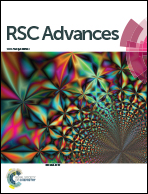Sequence-specific recognition of a coding segment of human DACH1 gene via short pyrimidine/purine oligonucleotides†
Abstract
With growing in vivo evidence of the roles of triplexes in biological processes, oligonucleotide-directed targeting of double-helical DNA for selective modulation of gene functions has become imperative in their therapeutic aspects. This study comprises a comparative investigation of 17-mer Py- and Pu-TFO for the formation of an intermolecular triplex with a 27-bp genomic homopurine–homopyrimidine track present in the transcriptional element of the human DACH1 gene. The biochemical and biophysical studies have revealed that triplex formation takes place only with Py-TFO and not with its Pu-counterpart. Non-denaturating gel electrophoresis indicated the formation of an intermolecular triplex in Py-motif with an increasing amount of Py-TFO, whereas no such interaction was observed for the Pu-counterpart. UV-thermal melting (Tm), circular dichroism (CD) and thermal difference spectra (TDS) studies confirmed the pyrimidine motif triplex formation, which was observed to be significantly pH-dependent and stable at acidic pH (5.2) in the presence of 100 mM Na+ ions. Contrarily, Pu-TFO was not found to bind to the target predominantly, owing to its self-association properties. Further studies have revealed that the GA-rich Pu-TFO adopts a homoduplex structure leading to a limit in its availability for triplex formation. These results may add to our understanding of sequence-specific gene targeting and give insight into designing more specific TFOs depending on genomic targets.



 Please wait while we load your content...
Please wait while we load your content...